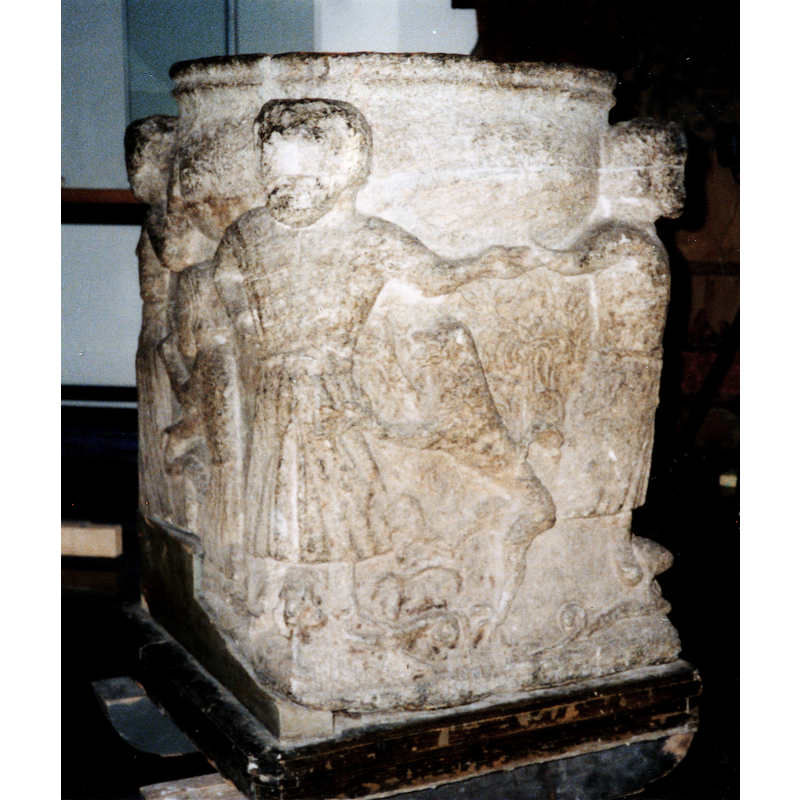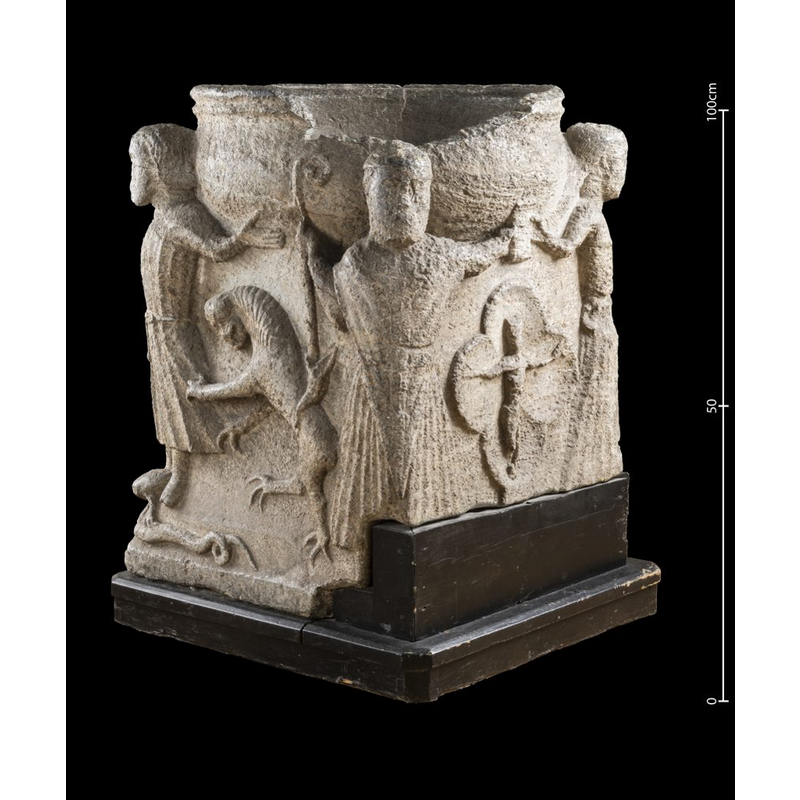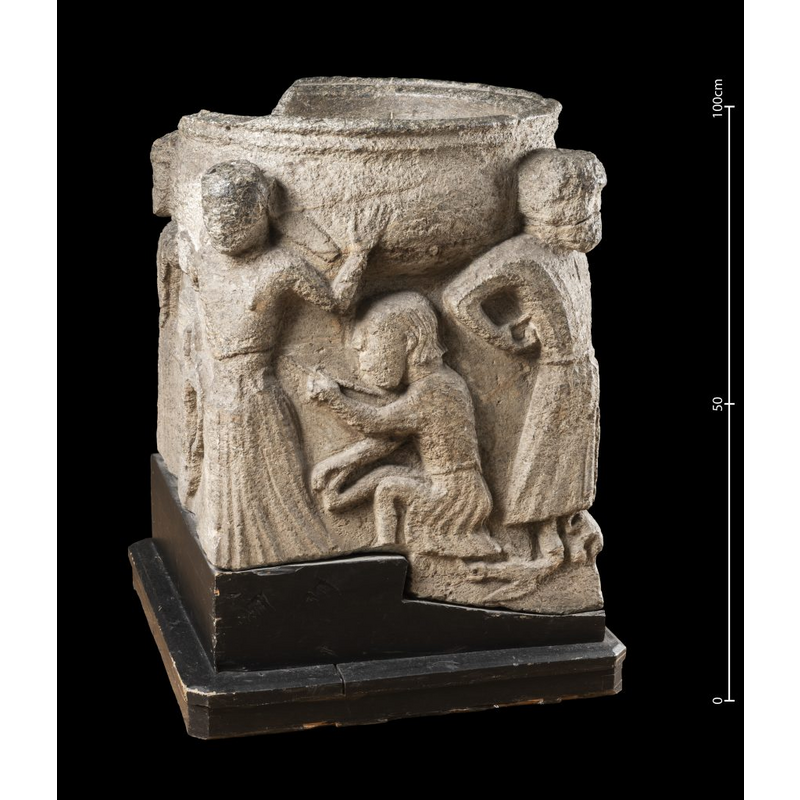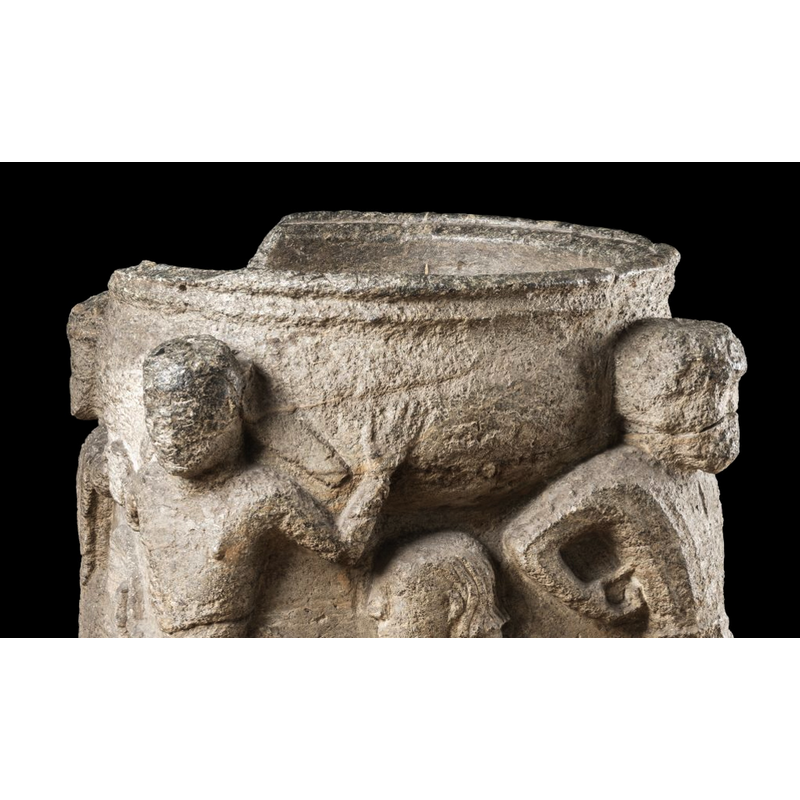Os / Óss

Image copyright © Colin S. Drake, 2000
Photograph and permission received from the author
Results: 13 records
Church - cleric - bishop - standing - wearing mitre - holding staff
Scene Description: most of the mitre is lost; the left hand could be holding a small book; the bottom of the staff appears to connect with the tail of the lion
Copyright Statement: Image copyright © Bergen University Museum, 2022
Image Source: digital image of a photograph by Adnan Icagić [https://churchart.w.uib.no/6-dopefont-fra-os/] [accessed 22 March 2025]
Copyright Instructions: Assumed CC
New Testament - Passion of Christ - Crucifixion
Scene Description: a Christ in a crucified position withour cross; inscribed in a quatrefoil
Copyright Statement: Image copyright © Bergen University Museum, 2022
Image Source: digital image of a photograph by Adnan Icagić [https://churchart.w.uib.no/6-dopefont-fra-os/] [accessed 22 March 2025]
Copyright Instructions: Assumed CC
animal - amphibian - frog or toad
animal - mammal - lion - rampant
Scene Description: to the left of the bearded man on the left; is it a lion?
Copyright Statement: Image copyright © Bergen University Museum, 2022
Image Source: digital image of a photograph by Adnan Icagić [https://churchart.w.uib.no/6-dopefont-fra-os/] [accessed 22 March 2025]
Copyright Instructions: Assumed CC
animal - reptile - snake
human figure - female
Scene Description: seen here on the left, her arms raised and stretched; a breast is discernible
Copyright Statement: Image copyright © Bergen University Museum, 2022
Image Source: digital image of a photograph by Adnan Icagić [https://churchart.w.uib.no/6-dopefont-fra-os/] [accessed 22 March 2025]
Copyright Instructions: Assumed CC
human figure - male - Spinario
human figure - male - bearded - standing
Scene Description: seen here in profile on the left; arms stretched
Copyright Statement: Image copyright © Bergen University Museum, 2022
Image Source: digital image of a photograph by Adnan Icagić [https://churchart.w.uib.no/6-dopefont-fra-os/] [accessed 22 March 2025]
Copyright Instructions: Assumed CC
human figure - male - bearded - standing - arms akimbo
Scene Description: seen here on the right; something unidentified at his feet
Copyright Statement: Image copyright © Bergen University Museum, 2022
Image Source: digital image of a photograph by Adnan Icagić [https://churchart.w.uib.no/6-dopefont-fra-os/] [accessed 22 March 2025]
Copyright Instructions: Assumed CC
human figure - standing - holding hands - 4
Scene Description: Four human figures in medieval dress hold hands around the basin sides
Copyright Statement: Image copyright © Colin S. Drake, 2000
Image Source: colour photograph [date unknown, probably ca. 2000] by Colin S. Drake
Copyright Instructions: Photograph and permission received from the author
view of basin - detail
Scene Description: the woman with a bare breast on the left; a bearded man on the right
Copyright Statement: Image copyright © Bergen University Museum, 2022
Image Source: digital image of a photograph by Adnan Icagić [https://churchart.w.uib.no/6-dopefont-fra-os/] [accessed 22 March 2025]
Copyright Instructions: Assumed CC
view of church exterior in context
Scene Description: Source caption: "Lysekloster kapell, a small wooden church from 1663, 300 metres from the Lyse Abbey or Saint Mary's Abbey, Lyse (Norwegian: Lyse kloster or Lyse Mariakloster), a now-ruined Cistercian monastery in the municipality of Os in the county of Hordaland in south-western Norway, approx. 25 km from Bergen. [...] Lysekloster kapell er en langkirke som ligger rundt 300 meter fra ruinene av Lyse kloster, i Lysefjorden i Os kommune, Hordaland fylke. Kirken ble vigslet i 1663 og er i privat eie under Lysekloster hovedgård."
Copyright Statement: Image copyright © Wolfmann, 2019
Image Source: digital photograph 29 November 2019 by Wolfmann [https://commons.wikimedia.org/wiki/File:Lysekloster_kapell,_Lyseklostervegen,_Os,_Hordaland,_Norway_November_afternoon_sunset_light_2019-11-28_DSC01226.jpg] [accessed 22 March 2025]
Copyright Instructions: CC-BY-SA-4.0
INFORMATION
FontID: 02093OSS
Object Type: Baptismal Font1
Museum and Inventory Number: Bergen University Museum -- Haakon Sheteligs plass 10, 5007 Bergen, Norway -- Tel.: +47 55 58 00 00
Church/Chapel: [original church unknown, perhaps the former Cisterian monastery now in ruins] [cf. museum information]
Church Patron Saints: [St. Mary]
Church Location: Landboden 30, 5200 Os, Norway -- Tel.: +47 56 57 24 00
Country Name: Norway
Location: Hordaland
Directions to Site: Os is located at Bergenshalvøya, 30 km S of Bergen. Osøyro; on the E39, between Bergen (27 km S) and Stavanger [formerly in the municipality of Osøyro, in Bjørnafjorden since 2020]
Font Location in Church: [in a museum]
Date: ca. 1225-1250
Century and Period: 13th century, Romanesque
Credit and Acknowledgements: We are grateful to Colin S. Drake for the photograph of, and information on this font
Font Notes:
Click to view
Listed by Enlart (1902) as being a "fonts quatrilobés soutenus par quatre personnages" and dated tentatively to the 13th century. Described by Drake (2002): "Monolithic tub font carved so that there is a distinct bowl at the top apparently held up by the four figures at the corners". Listed and illustrated in Kroesen & Kuhn (2022): "Baptismal Font from Os. This thirteenth-century font from Os has a remarkable shape and a rich iconography. The circular basin with a profiled rim is surrounded by four supporting corner figures that create a transition to the square base. The rather coarsely carved figures represent two bearded men, a bishop with a mitre and crozier and a woman with her breasts exposed. They hold their arms stretched out, forming a wreath around the basin. The woman’s hair carries a runic inscription that has been read as ákalit (‘invocation’). Together, the bishop and the woman hold a book inscribed with several letters, possibly A B B A (‘father’). Between the two men, and between one of these men and the bishop, are jumping lions. The third side shows a sitting man who grabs his foot with one hand and holds a stick in the other, probably a thorn-puller (spinario), a symbol of victory over evil. The fourth side features a quatrefoil with a crowned Christ in a cruciform posture but without a cross. Under the feet of the two bearded men are snakes and a toad-like creature; the opposite side of the base is damaged. Bendix Bendixen’s interpretation of the community (the men and the woman) and the clergy (the bishop) who gather around the Baptismal font to vanquish evil in the shape of the trampled animals, seems convincing. The lions may symbolize Christ (as the Lion of Judah) whose death on the cross, which is also shown, brings Salvation. However, the fact that one of the animals has its mouth open might express the opposite, the threat of evil and death. Mona Bramer Solhaug interprets the half-naked woman as a personification of adultery (luxuria). She mentions several fonts following similar models with circular basins supported by four corner figures in countries surrounding the North Sea and further south, in French Brittany. The use of local soapstone, however, leads her to conclude that this example was produced in Norway, possibly by a foreign stone carver. Soapstone. H 91 x W 67 cm."
COORDINATES
UTM: 32V 304259 6677479
MEDIUM AND MEASUREMENTS
Material: stone, soapstone
Number of Pieces: one
Font Shape: tub-shaped
Basin Interior Shape: round
Basin Exterior Shape: round
INSCRIPTION
Inscription Language: Letters and Runic
Inscription Notes: [cf. FontNotes]
Inscription Location: [cf. FontNotes]
Inscription Text: [cf. FontNotes]
Inscription Source: [cf. FontNotes]
REFERENCES
Enlart, Camille, Manuel d'archéologie française depuis les temps mérovingiens jusqu'à la Renaissance, Paris: Alphonse Picard & fils, 1902
Kroesen, Justin, The Medieval Church Art Collection: University Museum of Bergen (Norway), Regensburg: Verlag Schnell & Steiner, 2022



![Source caption: "Lysekloster kapell, a small wooden church from 1663, 300 metres from the Lyse Abbey or Saint Mary's Abbey, Lyse (Norwegian: Lyse kloster or Lyse Mariakloster), a now-ruined Cistercian monastery in the municipality of Os in the county of Hordaland in south-western Norway, approx. 25 km from Bergen. [...] Lysekloster kapell er en langkirke som ligger rundt 300 meter fra ruinene av Lyse kloster, i Lysefjorden i Os kommune, Hordaland fylke. Kirken ble vigslet i 1663 og er i privat eie under Lysekloster hovedgård."](/static-50478a99ec6f36a15d6234548c59f63da52304e5/compressed/1250322004_compressed.png)